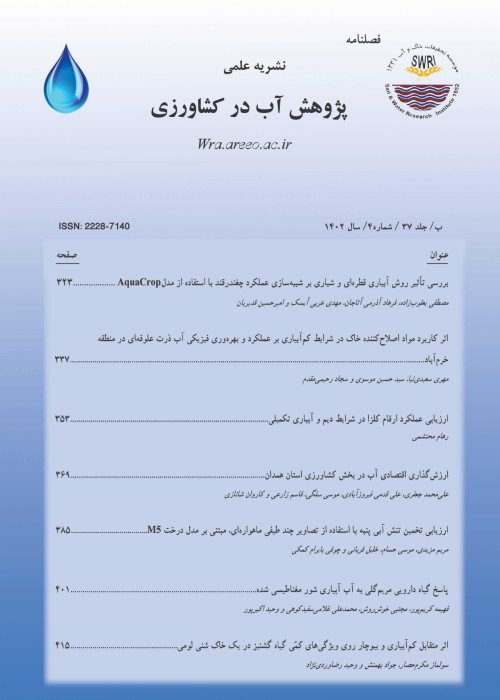Assessment of the SEBAL Algorithm to Estimate Actual Evapotranspiration in Neishaboor-Rokh Watershed Using SWAT Model
Abstract:
The SEBAL algorithm is used to estimate spatial distribution of actual evapotranspiration using remote sensing imageries of MODIS or Landsat. Despite having a better spatial resolution than MODIS imageries (30 m instead of 1000 m), Landsat imageries do not have an appropriate temporal resolution (every 16 days instead of daily). On the other hand, the daily imageries of MODIS can be difficult to use under cloudy condition. Additionally, it is also a time-consuming process to interpret all the imageries. In this research, we chose the appropriate imageries from MODIS to be able to monitor the sudden weather changes as well as rainfall events and to reduce the interpretation time, while keeping the important information of the daily MODIS imageries in order to obtain the better actual evapotranspiration estimates. Due to the importance of hot and cold pixel selection, whose selection needs time and proficiency, we applied the automated method of hot and cold pixel selection (without user-intervention) using Landsat imageries. To integrate evapotranspiration over time, we used linear-logarithmic interpolation method in addition to linear interpolation method. The estimated actual evapotranspiration by SEBAL was compared to the estimated actual evapotranspiration from water balance equation and SWAT model for 3 years including a wet year (2004-2005), a normal year (2005-2006) and a dry year (2007-2008) in the Neishaboor-Rokh watershed. Furthermore, we used the Budyko framework to validate the evapotranspiration estimated by SEBAL and SWAT. The results showed that in comparison to SWAT, the linear-logarithmic interpolation method performed better than the linear method to estimate evapotranspiration. For linear-logarithmic method, RMSE, MBE, and MAE were 20.4, 0.09, and 18.4 mm year-1, respectively; and for the linear method, they were 21.8, -2.4, and 20.8 mm year-1, respectively. The results also demonstrated that the SEBAL algorithm with automated cold and hot pixel selection is able to have a good estimate of actual evapotranspiration at annual time scale and watershed scale. But, the algorithm does not perform well at HRUs and monthly scale in comparison to SWAT model. Results showed that by taking irrigation into account, evaporation estimated by SEBAL and SWAT follows the Budyko framework.
Keywords:
Budyko , Interpolation , Landsat , MODIS
Language:
Persian
Published:
Journal of Water Research in Agriculture, Volume:30 Issue: 4, 2017
Pages:
525 to 541
magiran.com/p1656160
دانلود و مطالعه متن این مقاله با یکی از روشهای زیر امکان پذیر است:
اشتراک شخصی
با عضویت و پرداخت آنلاین حق اشتراک یکساله به مبلغ 1,390,000ريال میتوانید 70 عنوان مطلب دانلود کنید!
اشتراک سازمانی
به کتابخانه دانشگاه یا محل کار خود پیشنهاد کنید تا اشتراک سازمانی این پایگاه را برای دسترسی نامحدود همه کاربران به متن مطالب تهیه نمایند!
توجه!
- حق عضویت دریافتی صرف حمایت از نشریات عضو و نگهداری، تکمیل و توسعه مگیران میشود.
- پرداخت حق اشتراک و دانلود مقالات اجازه بازنشر آن در سایر رسانههای چاپی و دیجیتال را به کاربر نمیدهد.
In order to view content subscription is required
Personal subscription
Subscribe magiran.com for 70 € euros via PayPal and download 70 articles during a year.
Organization subscription
Please contact us to subscribe your university or library for unlimited access!



